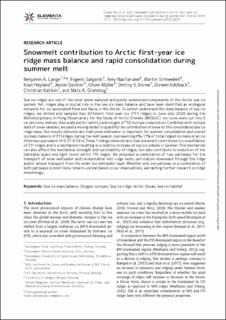| dc.contributor.author | Lange, Benjamin A. | |
| dc.contributor.author | Salganik, Evgenii | |
| dc.contributor.author | Macfarlane, Amy | |
| dc.contributor.author | Scneebeli, Martin | |
| dc.contributor.author | Høyland, Knut | |
| dc.contributor.author | Gardner, Jessie | |
| dc.contributor.author | Müller, Oliver | |
| dc.contributor.author | Divine, Dmitry V. | |
| dc.contributor.author | Kohlbach, Doreen | |
| dc.contributor.author | Katlein, Christian | |
| dc.contributor.author | Granskog, Mats A. | |
| dc.date.accessioned | 2023-08-10T15:00:14Z | |
| dc.date.available | 2023-08-10T15:00:14Z | |
| dc.date.issued | 2023 | |
| dc.identifier.uri | https://hdl.handle.net/11250/3083425 | |
| dc.description.abstract | Sea ice ridges are one of the most under-sampled and poorly understood components of the Arctic sea ice system. Yet, ridges play a crucial role in the sea ice mass balance and have been identified as ecological hotspots for ice-associated flora and fauna in the Arctic. To better understand the mass balance of sea ice ridges, we drilled and sampled two different first-year ice (FYI) ridges in June–July 2020 during the Multidisciplinary drifting Observatory for the Study of Arctic Climate (MOSAiC). Ice cores were cut into 5 cm sections, melted, then analyzed for salinity and oxygen (d18O) isotope composition. Combined with isotope data of snow samples,we used a mixing model to quantify the contribution of snow to the consolidated sea ice ridge mass. Our results demonstrate that snow meltwater is important for summer consolidation and overall ice mass balance of FYI ridges during the melt season, representing 6%–11% of total ridged ice mass or an ice thickness equivalent of 0.37–0.53 m.These findings demonstrate that snowmelt contributes to consolidation of FYI ridges and is a mechanism resulting in a relative increase of sea ice volume in summer. This mechanism can also affect the mechanical strength and survivability of ridges, but also contribute to reduction of the habitable space and light levels within FYI ridges. We proposed a combination of two pathways for the transport of snow meltwater and incorporation into ridge keels: percolation downward through the ridge and/or lateral transport from the under-ice meltwater layer. Whether only one pathway or a combination of both pathways is most likely remains unclear based on our observations, warranting further research on ridge morphology | en_US |
| dc.language.iso | eng | en_US |
| dc.rights | DNV | * |
| dc.rights.uri | http://creativecommons.org/licenses/by-nc-nd/4.0/deed.no | * |
| dc.title | Snowmelt contribution to Arctic first-year ice ridge mass balance and rapid consolidation during summer melt | en_US |
| dc.type | Journal article | en_US |
| dc.description.version | publishedVersion | en_US |
| dc.source.volume | 11 | en_US |
| dc.source.journal | Elementa: Science of the Anthropocene | en_US |
| dc.source.issue | 1 | en_US |
| dc.relation.project | EC/H2020/730965 | en_US |
| dc.relation.project | Norges forskningsråd:280531 | en_US |
| dc.relation.project | Norges forskningsråd:280292 | en_US |
| dc.relation.project | Norges forskningsråd:276730 | en_US |

